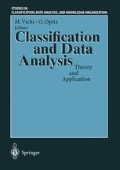Abstract
Surveys of spatially distributed phenomena are often conducted using geographical areas as strata. If CATI (computer assisted telephone interviewing) methodology is used to contact the units, it is possible to choose between two different methods of selecting the units to be interviewed: either from a full list of the population units or a selection based on RDD (random digit dialling) technique. On this last case it seems natural to telephone exchange areas as strata. This could be a very interesting solution from many point of views. The aim of this paper is to find a methodology to asses the opportunity of using such a pre-defined geographical stratification in comparison of the usual clustering methods, based on a set of auxiliary variables correlated with the phenomena under study, to define the strata. The choice will depend on the use of some measure of similarity and/or the evaluation of the homogeneity in the strata for the specific phenomenon to be analysed (in our application the evaluation of the loss of homogeneity is verified with respect to a hypothetical set of variables under study).
Access this chapter
Tax calculation will be finalised at checkout
Purchases are for personal use only
Preview
Unable to display preview. Download preview PDF.
References
Barry, B. (1966). Essay on commodity flows and the spatial structure of the Indian economy, Research paper 111, University of Chicago, Department of Geography.
Gordon, A. D. (1996). A survey of constrained classification, Computational Statistics & Data Analysis, 21, 17–29.
Hubert, L. & Arabie, P. (1985). Comparing partitions, Journal of Classification, 2, 193–218.
Jain, A. & Farrokhnia, F. (1991). Unsupervised texture segmentation using gabor filters, Pattern Recognition, 24, 12, 1167–1186.
Legendre, P. (1987). Constrained clustering, in: Developments in numerical ecology, Legendre, P. & Legendre, L. (Eds.), Springer, Berlin.
Mohadjer, L. (1988). Stratification of prefix areas for sampling rare population, in: Telephone Survey Methodology, Groves R. M. et al. (Eds.), John Wiley & Sons, New York, 161–173.
Openshaw, S. A. (1977). A geographical solution to scale and aggregation problems in region-building, partitioning and spatial modelling, Trans. Institute of British Geographers, NS 2, 459–472.
SAS, (1990). SAS/STAT User’s Guide, Ver. 6, 4 th Ed., SAS Institute, Cary, NC.
Zani, S. (1993). Classificazione di unità territoriali e spaziali, in: Metodi Statistici per le Analisi Territoriali, Zani S. (Ed.), Franco Angeli, Milano, 93–121.
Author information
Authors and Affiliations
Editor information
Editors and Affiliations
Rights and permissions
Copyright information
© 1999 Springer-Verlag Berlin · Heidelberg
About this paper
Cite this paper
Giusti, A., Petrucci, A. (1999). On the Assessment of Geographical Survey Units using Constrained Classification. In: Vichi, M., Opitz, O. (eds) Classification and Data Analysis. Studies in Classification, Data Analysis, and Knowledge Organization. Springer, Berlin, Heidelberg. https://doi.org/10.1007/978-3-642-60126-2_28
Download citation
DOI: https://doi.org/10.1007/978-3-642-60126-2_28
Publisher Name: Springer, Berlin, Heidelberg
Print ISBN: 978-3-540-65633-3
Online ISBN: 978-3-642-60126-2
eBook Packages: Springer Book Archive

